These Salty Homebuilt Fords Remind Us What Hot Rods Are All About
We tell everyone who will listen, and even some who don’t, that Bonneville Speed Week is among the greatest events in the country. The racing is phenomenal. The camaraderie is second to none. Even when competition is delayed due to weather, seeing the hot rods that make the pilgrimage to the salt each year makes the trip worthwhile.
During last year’s rain-delayed Speed Week, we spotted Ben Smith’s duo of matching hot rods. The Model T roadster and Model A sedan looked unique in that they were understated yet eye-catching. Their construction appeared totally no-nonsense, which led us to ask Smith about how he came to own such a well-matched pair of prewar Fords.

Smith had wanted a hot rod of some sort for ages, but he never had a place to keep one. It wasn’t until he got a three-bay shop behind his home in Lynwood, Washington, that he could finally take on the project he’d been planning for years. His background in building off-road trucks and oval-track race cars gave him the foundation he needed to bring his vision to life.
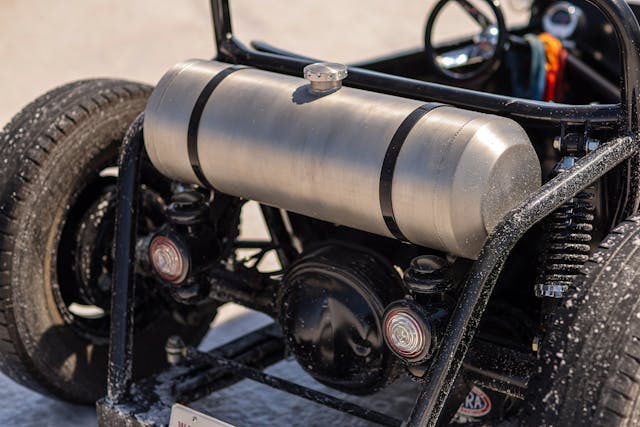
His first step was to trade for a fiberglass Model T body. He then put his metal fabrication skills to work by building the chassis from scratch. The rear suspension uses trailing arms and a Panhard rod to locate a Ford 9-inch axle pirated from a Bronco. The coil springs mount to a tube that closely follows the curves of the back of the cab. It ties into the roll hoop which is supported by tubes that stretch to the frame rails.
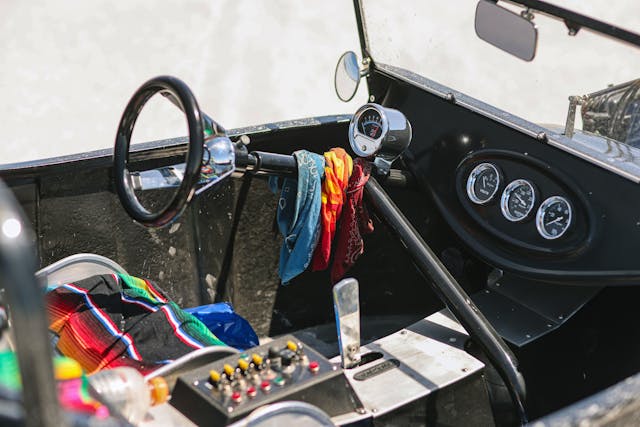

Smith wanted to enjoy the T with others, and that meant making it roomy enough for him and a copilot. Noting that he’d rather sit in the car than on it, he split the body down the middle and widened it by six inches. The body was seamlessly fiberglassed back together over some wood reinforcements.
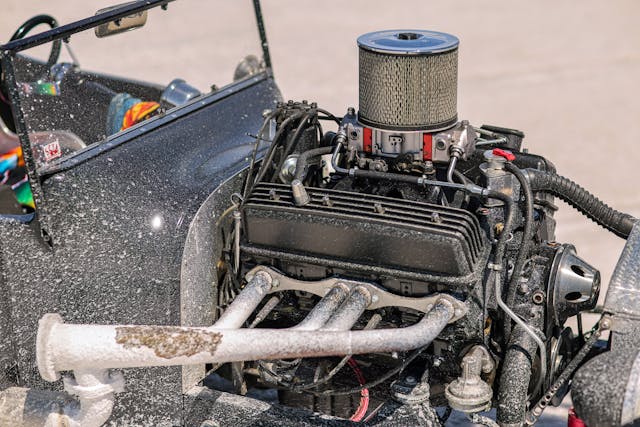
When it came time to find a powerplant for the T, Smith found a few used Chevy small-blocks, but none of them panned out. The engine he ended up with is one of three built for a boat. Dyno testing on all three examples showed that this one was a bit down on power, so he purchased at a discount what amounted to the runt of the litter. He swapped the cam, bolted on a Turbo 350, and has been enjoying it ever since. With so little mass to haul around, it’s more than enough power to get into trouble.
The T was built to be driven, so Smith wasn’t concerned with impressing show judges or anyone else. The result of form following function is still very pleasing, although Smith describes it as “nothing too fancy.” Dive a bit deeper and you’ll notice a couple of concessions to utility; for example, if the body got in the way of anything that would make maintenance difficult, Smith added an access panel. The simple and functional fuse/switch panel is mounted in plain sight and easy to reach. That’s a driver’s version of hot rod engineering.

To keep the budget in check, Smith opted for new parts that merely look old, rather than scouring swap meets and paying big for correct vintage parts. “I kind of just threw stuff together that I could afford that was easy to get. I’d rather drive than hunt.” Consequently, a lot of the car’s parts came from the Speedway Motors catalog. Some of the new parts he purchased were discounted—scratch and dent examples. They saved money but required some extra elbow grease to look presentable.
Building the Model T took Smith about a year. “I just wanted something affordable and easy,” he said. The car was the first test for his hot rod vision panning out in real life. Smith enjoyed the T-bucket for a year or two, but eventually, he got the itch to build another hot rod. He already had some finned Buick brake drums … and it would be a shame to let them go to waste.
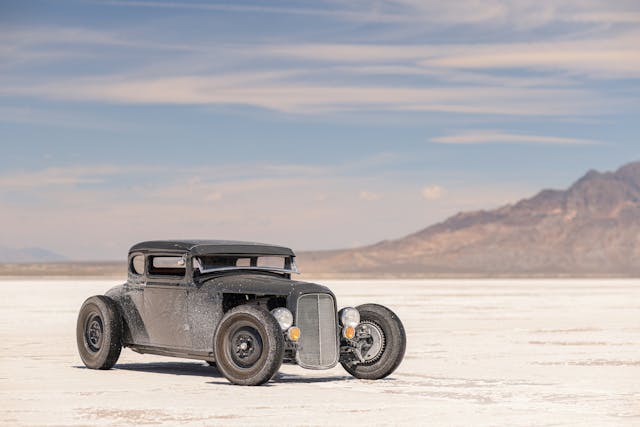
Thus began Smith’s Model A. The real start of the project began with an already-chopped and channeled coupe body that needed quite a bit of work. First, however, the top was a bit crooked. Smith remedied that with some careful bodywork. He also shaped the shallow-curved roof panel on an English wheel, doing the work himself—no small feat for an amateur bodyman. Like the T roadster, his A coupe was born of Smith’s love of traditional hot rods. “I just like clean and simple,” Smith told us, “If it doesn’t need to be there it shouldn’t be there.”

Naturally, Smith’s “clean and simple” Model A does have some aesthetic touches that any hot-rodder would appreciate. Note the shortened ’32 Ford grille shell, which is a classic addition to any A coupe hot rod. Smith dressed up his interpretation with the elliptical grille from a ‘50s screen door. Another nice touch is the steering: The Pitman arm and steering box are mounted inside the cab, while the drag link exits from a scoop mounted low in the cowl.

These days, Smith has slowed down on building oval track cars and off-road trucks. However, he still does build oval track engines. The A is the beneficiary of one seriously stout small-block Chevy that isn’t too far off from what you’d find slinging dirt and getting sideways on a fairgrounds track on a Saturday night. The 370-cubic-inch short block is topped with cast iron World Products heads, a Weiand intake, and a Carter AFB carb. Like the T, it sends power to a Turbo 350 transmission and then to a Ford 9-inch rear axle. Rather than a junkyard Bronco, this rear axle is from Quick Performance.
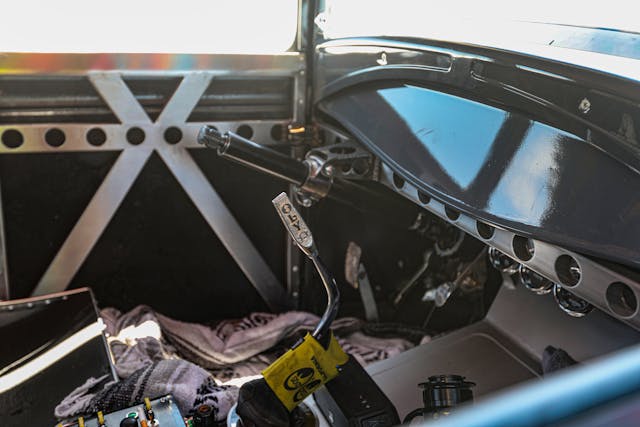



The roadster’s body is finished in a hot rod flat black, with the remaining pieces sprayed in gloss black. Smith wanted something just a bit different for the coupe, and after waffling on the decision for months, he decided on a custom mix that’s 3:1 black/white. He finished it all up just a week before heading out to Bonneville for Speed Week 2023. Since then, on most clear days he has driven one or both of the cars. A few times he’s even driven them in the rain.
Either of these builds would look great on its own, but they look especially great together. You can find more images of the A and T on Smith’s Instagram. But come on, wouldn’t you rather just come out to Speed Week and witness them on the salt for yourself?
***
Check out the Hagerty Media homepage so you don’t miss a single story, or better yet, bookmark it. To get our best stories delivered right to your inbox, subscribe to our newsletters.



One of my best friends, watching him build both these cars from scratch was amazing. He is self taught for the most part. Can’t wait to see whats the next build is going to be.
I like that he chose a shopease over showpiece approach in building both hot rods. Drive and enjoy them, break them and rebuild them better. Actually know and understand what you’re driving.
They are both gorgeous, especially the A. You can tell it’s a personal build when none of the fuses or switches are labeled! But why are they automatics??
Guess I can answer my own question: because the builder wants them that way.
Looks like a good combo. All that salt spray makes me want to detail the heck out of those cars.
This car brings a smile to my face. It looks better than anything coming off an assembly line today. So cool.
I love the coupe.
Old school hot rods in modern times. Gotta love it! And I gotta get back on my 3WD and get it on the road.
I entered the world of hot rods at 24 when I finished a auto parts and inventory management program in college. An acquaintance of mine had a friend who ran a vintage and rod parts shop. He recommended me and I got the job as well a crash course in automotive history. It is a fantastic world of mechanical pleasure that cannot be had at any price in modern autos. Hell, my boss actually called my ’64 Comet a late model car when I started working there. Later I understood why. At that time the builders preferred the term ‘streetrod’ to hot rod and many were covered in bright colours and a lot of billet. They were nice but the few customers that went against the tide and built old time looking gowjobs impressed me the most. Open hoods and dark paint! I have very much enjoyed seeing the return to traditional rods. Too cool for school bitchin’ rides.